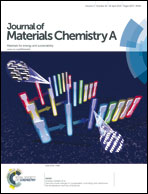Morphology effects in photoactive ZnO nanostructures: photooxidative activity of polar surfaces†
Abstract
A series of ZnO nanostructures with variable morphology were prepared by a microemulsion method and their structural, morphological, and electronic properties were investigated by a combined experimental and theoretical approach using microscopy (high resolution transmission electron microscopy) and spectroscopic (X-ray diffraction, Raman, and UV-visible) tools, together with density functional theory calculations. The present experimental and computational study provides a detailed insight into the relationship between surface-related physicochemical properties and the photochemical response of ZnO nanostructures. Specifically, the present results provide evidence that the light-triggered photochemical activity of ZnO nanostructures is related to the predominance of highly-active (polar) surfaces, in particular, the amount of Zn-terminated (0001) surfaces, rather than band gap sizes, carrier mobilities, and other variables usually mentioned in the literature. The computational results highlight the oxidative capability of polar surfaces, independently of the degree of hydration.


 Please wait while we load your content...
Please wait while we load your content...